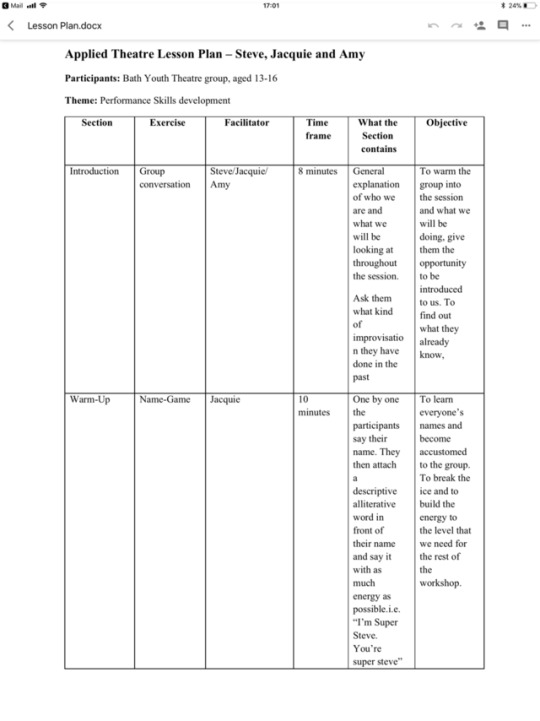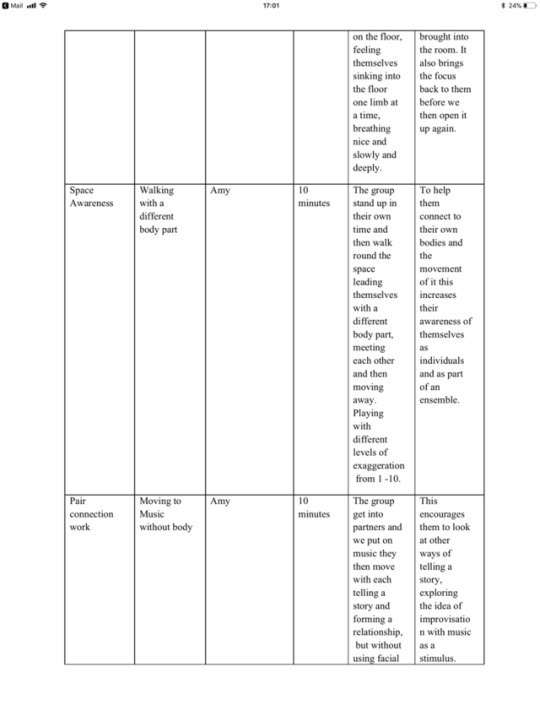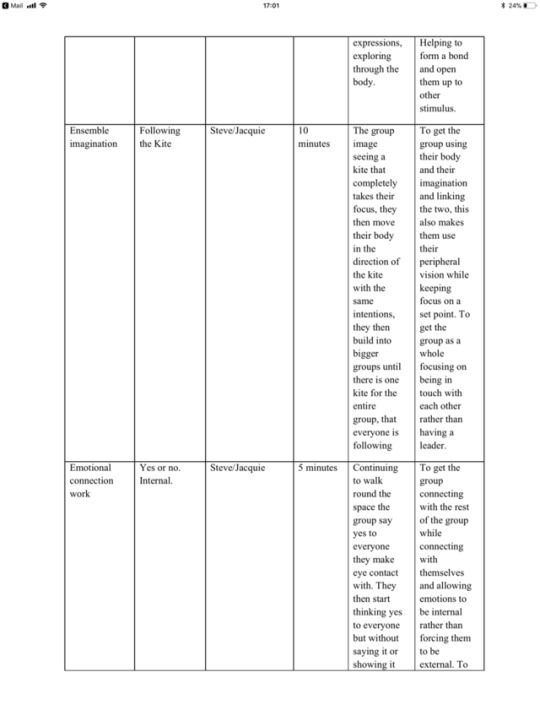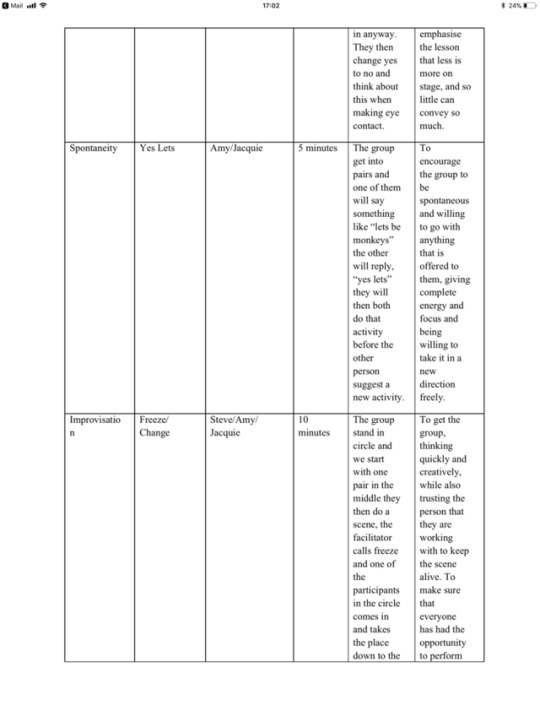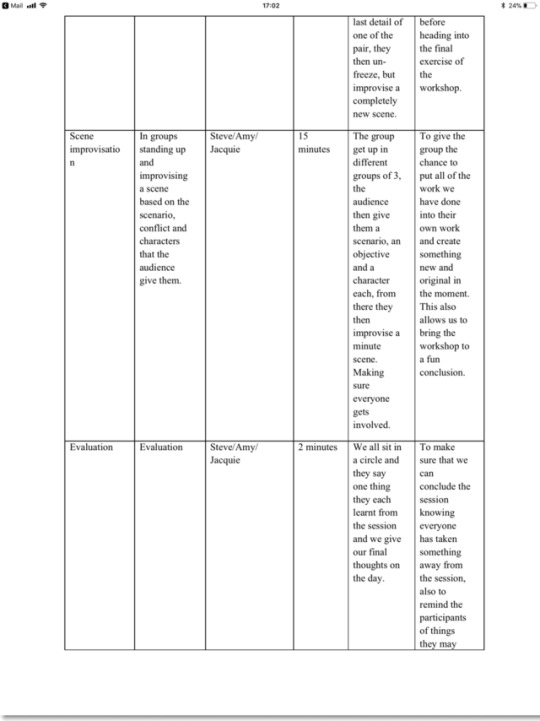Text
Workshop Reflection
The workshop ended up being a success due to the participants being engaged during the workshop and maintaining a high level of enthusiasm towards the exercises. Each exercise transitioned smoothly and built up the prepared improvisation skills and the confidence of the group just as we had planned. Due to some exercises running on longer than we had initially scheduled, and a much needed, however, unplanned break due to the sudden rise in temperature in the studio and physical activities, we had to think on the spot and cut out our lesser important activities, this still seemed to work well and gave us enough time at the end for our ‘main’ activity which was the improvisation scenes. Throughout the process our group: Steve, Amy, and I, worked really well together. Steve has plenty of experience delivering workshops and was an incredible asset to our team. He was very professional, engaging and built a strong bond with the young people as soon as they came through the door. Amy has also had experience with young people and a very good knowledge of drama games which worked very well for our group as we could combine all of our experiences and deliver a great and balanced workshop. I also have experience with young children, however, when delivering ‘workshops’ in the past, I would always be playing a ‘character’ of some sort and I would be delivering them alone. It was both difficult yet reassuring to deliver a workshop with other facilitators. Difficult in a way that we had to stick as close to our plan as possible and not jump in and talk over the others, but also contributing enough as not to be lazy by being carried by the others. I think our balance worked well and we had an equal amount of leading and side coaching. If we were to do it again, I would edit the name game slightly and ask for a describing word for them to put in front of their names and eliminate the ‘conditions’ the participants label themselves as, For example, one girl labelled herself as ADHD, another, ADD, this was an interesting experience for us delivering the workshop as it was quite shocking to see people so young being so open about a condition and using that to label and identify themselves. We would also plan for a quick 5-10minute break as we didn’t realise how important this was until we needed it. We would potentially edit the Big Booty exercise as it took longer than expected and we didn’t get the gist of it in time, it was potentially too complicated to do in the short amount of time, the same with the stomping rhythm pre-exercise/ transition, we would simplify it for next time and depending on how easy the group picks it up, could then make it more complicated.
0 notes
Text
Theatre of the Oppressed
By Augusto Boal
Part Two
Explain in your own words :
1 Third stage - Theatre as language. 1st degree - simultaneous dramaturgy , 2nd degree - image theatre.
In the 1st degree - simultaneous dramaturgy section Boal is trying to bridge the distance between performer and spectator, and in the process receiving a better understanding of the group. Using his example about the illerate woman getting revenge on the cheating husband, we have the actors performing a scenario and then leaving the spectators to give suggestions on what happens next. Through playing out the different scenarios suggested, and the reaction of the group to the outcome, gives the facilitator a good understanding of the group and at the very beginning, gets the participants excited and engaged. Also by doing this exercise, it relates back to the polarity of the fixed and the free. By giving the participants a scenario, it's setting rules, however, it also gives them creatives freedom as they get to decide what happens next. This then leads onto the 2nd degree - image theatre, which is turning thoughts into images instead of using words, this can help 'paint' a picture for the spectator. Using images instead of words can make a message or story clearer adding another element to interpret. After all, as cheesey as it sounds 'a picture speaks a thousand words'. A good example from Boal is when a woman used the word 'embrace' when describing a meeting with her boyfriend. To me, the word embrace represents warmth, safety and security, it is a hug, something loving and caring, however, when the young woman showed her version of embrace, when her boyfriend hugged her, "embraced her", her arms were folded, this gives off a cold, closed off, or anxious interpretation and states that there is something wrong here, hence the struggles she's been having.
2 Fourth stage - Theatre as discourse.
I believe Boal's fourth stage a theatre as discourse, is the "finished" product, where the spectator creates a final story that can be performed. It can consist of different styles/ techniques such as:
- Newspaper theatre
- Invisible theatre
- Photo romance
- Breaking of repression
- Myth theatre
- Analytical theatre
- Rituals and masks
This is where the participants take everything they have learnt through rehearsal and previous exercises and put it into practice.
3 In detail - How might you use these stages in your own work?
I would use these stages within my own work by applying the exercises Boal uses for my workshops. Starting with stage one, 'getting to know the body, it's limitations and possibilities, it's social distortions and possibilities of rehabilitation' (Boal, 2008, pg.102) using some gentle physical warm ups, combining this with becoming aware of the space. We will begin by getting the participants to walk around the space, bringing attention to the space beneath their feet, the space above their heads, and the space around their bodies, also in comparison to the other people within the space, we then move on to forming pairs to begin the 'hypno-hand' exercise. The pairs take it in turn leading and following the hand, during this exercise the participants explore different movements and positions of the body, some they haven't experienced before, throughout this exercise the groups the join together until the whole group is working at one. As the participants become more comfortable, this will lead onto the second stage, making the body expressive, where they can start representing emotion and characterisation through the use of their bodies. A good exercise to achieve/introduce this would be the 'weight/air' exercise, throughout this exercise, the participants still walking around the space, imagine a weight, or helium balloon, in various parts of the body, and then noticing the effect it has on the body and what type of characterisation this produces. For example, a heavy weight in the shoulders could represent someone who is very stressed, someone who holds a lot of responsibility, who could be exhausted and/or crushed by the weight, the opposite of this could be if the participants had a helium balloon lifting their chest up, this could represent a character filled with pride or arrogance. We then go onto stage three, my personal favourite, 'the theatre as language'. The theme or scenario we use for the exercises would depend on the group we are working with. For this particular example I'm going to use prison rehabilitation. After we have completed our warm ups, have become aware of our physicality and have touched upon characterisation, we will then discuss topics that resonate with our group and pick three common themes, or emotions, a quick example would be, anger, remorse and hope, now using these three words, the group without speaking, turn these into three images. We will then discuss these images and analyse them further, upon discussion leads to a scenario that a few people act out, this could be an argument that excalates into violence or something similar. Using forum theatre we get the participants to change and adapt the original piece to something with a more positive outcome and see if different actions can dissolve a potential problem before it has chance to happen. A discussion can then take place, perhaps this could help the participants reflect on their own lives and the choices they make.
Finally, this brings us to the fourth stage where the participants, using the skills they've learnt previously during the workshops, put together a final production, this doesn't have to be a performance as such and it doesn't have to be performed on stage.
0 notes
Text
Theatre of the oppressed
By Augusto Boal
Part one
1) What specifically stood out for you in the Boal reading? ( Give 2 examples. Be specific) What is your response to that? (Did it make you think about something - if so, what? Did it raise questions for you - if so, what are they?)
I found the portraying language through images and performance interesting as sometimes we can over complicate communication through words (speaking from experience) and globally we don't all speak the same language. Performance is a great way to communicate in a manner that everyone can understand, especially through images and by using our bodies. On a daily basis we use various means to communicate, our body language, tone of voice and the words spoken. It is surprising that body language communicates the most and the actual words the least. This I believe is very useful for communicating a message using performance as it unites people, who would otherwise be disconnected due to the language barrier. I believe heavily in the communication using our bodies as, I do it at work. I enjoy interacting with people and due to a language barrier between me and one of the night employees we communicate with over exaggerated hand gestures and facial expressions, this is very handy as otherwise she would feel rather distant at work and may not enjoy it as much because she doesn't have much interaction with her other colleagues. Making people feel connected is important as no one wants to feel alone.
Another point I found interesting was the exercise where the performers would play out a scenario and ask the audience for contributions on what the characters should do next. This is a handy exercise for applied theatre work, especially when working in rehabilitation as it gets the participants to think about how their actions influence consequences. By showing them the different outcomes to the choices they make can bring them more awareness of situations happening within their own lives and could result in them making a better decision that can influence a more positive outcome.
2) What can we learn from Boal's experience with the mans picture of home on pg 100?
We learn that meaning and language can be conveyed through more than words or our body. We learn that an image of "home" doesn't need to be a picture of "our home" or in this case, the river, the shack etc. A more powerful message can be communicated in a symbolic form. The picture of the boy shows the true struggles and horrors of where the man lives, it doesn't show the false illusion of a cosy home, or a chilly cramped living space, it conveys real emotion, and although using a symbol may make the initial message harder to understand, it brings another level of realism and depth to the living conditions and shows the day to day battles.
3) Please explain Boal's first two sections (1. Knowing the body, 2. Making the body expressive) briefly in your own words.
Knowing the body is about becoming aware of its limitations and its strengths, its about exploring what works and what doesn't. Boal also mentions that work affects the structure of the body for example an office worker who sits at a desk all day typing away will not have the same muscle structure in their legs as a watchman who is consistently on their feet pacing. It is not about finding weakness, it is about becoming aware. This leads us on to making the body expressive, this means using the body to convey emotions. By using the body to convey emotion makes the emotion more believable than using words, for example, if a person was sad, it would be very silly for them to merely say the words "I'm sad" it doesn't convey much meaning on its own, whereas having slumped shoulders, the head tilted toward the floor would convey a more realistic emotion. The body would be more withdrawn and closed off if the person was experiencing a negative emotion whereas if they were experiencing a positive emotion their body would be more open and relaxed.
0 notes
Text
Laying the Foundations: A guide to youth drama facilitation
David Kelly
1) Is a game ever just a game in Applied Theatre?
A game in Applied Theatre is never just a game, it may be ‘the simple joy of playing, and experiencing all the same fun and pleasure attributed to the games of our childhood’ (2018, David Kelly, pg.19), however, it also contain hidden objectives. The hidden objectives these games possess are designed to help ‘foster the artistic, social and personal development of everyone involved’, dissolve physical and nervous tension within the group, create a safe space for the group, and to bring a sense of equality and inclusiveness to the group’s environment.
2) How would you describe the role of a facilitator?
The role of the facilitator is to create a safe and an equal environment for their participants to work in, they teach, guide and support their participants whether it being new skills or harnessing the skills they already possess, provide their participants with freedom and independence, and having the awareness needed in order to maintain the focus or the group, and, noticing and addressing the group’s energy.
3) What is the purpose of feedback in an Applied Theatre session?
Feedback provides the opportunity for the facilitator to get a better understanding of the group and for the group to have time to reflect on what they have learnt, and engage with what other members of the group have learnt also. It is a chance to receive and give out constructive criticism, provide reassurance, give shyer members an opportunity to speak their opinion, and is a great starting point for a discussion.
0 notes
Text
The Geese Theatre Handbook
Geese Theatre
1) Describe in your own words Geese theatres' key theories.
The key theories Geese Theatre work with are:
- Social learning theory, which suggests learning through observation and imitation, this is actually one of the main ways we learn. Starting from a very young age we learn behaviours through watching and mimicking our parents, older siblings and then classmates and so on, as we grow bigger, so does our circle of influences.
- Cognitive behavioural Theory suggests the way we think, feel and act, this then affects our behaviour. For example, having a negative mindset or perspective on a certain subject, could result in a negative outcome and vice versa.
- Role Theory suggests we play a role, whether it be mother, father, son, daughter, teacher, student, etc. We associate certain behaviours with these roles so therefore we behave in the appropriate manner, however, we may have multiple roles and behave differently depending on which role we’re playing and who we’re with.
2) What specifically stood out for you in the Geese theatre reading? (Give 2 examples. Be specific. Did it make you think about something - if so, what? Did it raise questions for you - if so, what are they?)
When reading this handbook, the Cognitive Behavioural Theory stood out to me as it is an interesting concept and would benefit the work of Geese Theatre. They state that by making a person aware of their thoughts and perspective, that they can then work on improving it, which will result in more positive behaviour. For example, by getting an offender to realise they’ve been thinking about a subject in a negative manner, they have the power to change the way they think into a more positive perspective, resulting in a more positive outcome. This works perfectly for helping offenders with their rehabilitation.
Another point that I found interesting was Encouraging Deeper communication as communication is one of the biggest attributes to building and maintaining relationships. If someone struggles to communicate either because they’re shy or they don’t know how to, they may become frustrated and begin to feel isolated which could cause negative behaviours. It is quite common for children to act out if they feel they’re being misunderstood or not listened too or valued, by addressing this at an early age, or teaching someone how to communicate in a positive manner can be really beneficial and decrease negative behaviour and outcomes.
3) How does the work of Geese theatre company join up with the wider world of Applied theatre and the idea of dominant narratives?
Geese Theatre joins up with the wider world of Applied Theatre as they aim to help the people they work with, whether it’s through rehabilitation, trust building, or so on. Applied theatre is telling a story, it’s about applying theatre in any setting, and by listening to the people they collaborate with and work closely aside, they do that. They tell the story of those who wouldn’t normally have a voice, they help and guide people to live their lives in a more positive manner.
0 notes
Text
House of Games
Chris Johnson
1. In your own words discuss what Johnson means by the six polarities
The six polarities are six contradictions that are essential when working with a community using Applied Theatre. Though theses key relationships are opposite, they still rely on each other in order to create an equalibrium as one cannot exist without the other, just like light cannot exist without darkness.
The six polarities are:
1) the fixed and the free
2) surface and depth
3) The centre and the edge
4) individual and the collective
5) the performer and the audience
6) the simple and the complex.
2. Choosing one of the polarities name a situation where a facilitator might encounter one.
Taking the individual and the collective as an example, when facilitating, is it important to consider this polarity as the group you’re working with may share common themes and cultural context, being there for a specific reason, they are also an individual with their own opinions, thoughts, feelings, and needs. The facilitator needs to consider this polarity carefully in order to maintain an equal and safe environment for all participants.
3. Describe how Johnson's descriptions of polarities might relate back to last week's reading?
Last weeks reading by Preston states the importance of a facilitator having critical awareness which relates to this week’s reading from Johnson. Both stating that by having critical awareness takes great skill and judgement. It is important to be continuously aware of the group at all times in order to maintain the safe and equal environment and adapting their techniques or structure if the occasion arises.
0 notes
Text
Pedagogies: Critical Facilitation
Sheila Preston
1) What is meant by the term ‘critical pedagogy’?
Critical pedagogy is a political and philosophical theory that goes hand in hand with an applied theatre practitioner ‘attempting to apply theoretical agendas of social justice and transformation into practice, but in a critical and reflexive way’ (Preston, 2016, pg. 22) and enables awareness and understanding of cultural forms that are present within the community.
2) What does Preston mean when she refers to the ‘cultural context’ of the group?
The cultural context of the group is the circumstance of why they’re there, for example a group could be brought together by being refugees or through a mental health organisation, even people with learning disabilities or students at school. They all share a similarity which could be their ‘cultural background’, however, it is important to remember that they are individuals and sometimes don’t like being identified by the ‘label’ placed on them by society. Preston gives an example of this when she talks about her work with a group with mental illnesses. Through a discussion the men wished to put on a piece where their lead character was a man who had depression, where as the women didn’t want to do a piece about mental illness at all and instead created a piece regarding romance and fantasy.
3) Why is critical awareness important as a facilitator?
It’s important to have critical awareness as a facilitator because of various reasons; a facilitator needs to be aware of their own and others performativity in different spaces and the politics within their own lives and the lives of the participants. They also need to be aware of the participants needs and be sensitive to ensure the space around them is a safe and comfortable environment for all those involved.
0 notes
Text
Applied Theatre: International case studies and challenges for practice
Prendergast.M and Saxon.J
1) In what ways do any theatre experiences you’ve had, either as an artist or audience, resonate with any of the examples given in this introduction?
When performing a stage adaptation of George Orwell’s novel, 1984, our director wanted to make a political stance by leaving the audience thinking about their future and if it’ll turn out like the one in 1984 and whether they have the power to prevent a future like that from happening. I believe this is an example of Theatre for Development expressed in chapter one from the book, Applied Theatre: International case studies and challenges for practice, edited by Monica Prendergast and Julia Saxton.
An example of Theatre in Education was when I was an audience member and a small group of Theatre students came into an assembly at our primary school. They put on a short play about electricity which I still remember to this day, and vaguely remember the song about “light travelling in dead straight lines”. This was very beneficial at the time as it really helped with my future exams and remembering important information in a fun way.
2) What can we learn from the history of applied theatre? How could we use this knowledge in our practice?
The history of applied theatre has taught us that telling stories is more than simply telling a story. It reaches people. Taking theatre into the community brings around amazing opportunities to hear people’s struggles, their hopes and desires. Theatre is an important tool in tackling and creating awareness about issues dominating the world in order to make a change. The knowledge I have learnt will help me with my own work as I’ve found it is important to listen to the participants to discover what they want to do, do they want to tell their story in order to convey a message and make a change or do they want to have fun and distract themselves from their current struggles? It’s about listening, creating change, being inspirational and most importantly having fun.
3) How could you describe applied theatre to someone who has not read this introduction or experienced applied theatre in other ways?
Applied Theatre could be taken anywhere, it doesn’t have to be just in a theatre, it could be in a school, in a church, working with elderly people, in the street, or prison, or at home. It doesn’t have to be scripted or a full length play, it could come in many forms. Put simply, it is just telling a story. The community’s story. Your story.
4) Re-read the thumbnail description of applied theatre practices (pp 1-6), which of these types of applied theatre most draws your interest? What is it that attracts you to this form? Write a reflection that begins with ‘I could see myself working with this particular area of applied theatre because...’
I could see myself working in theatre for development because I like the idea of taking a current issue and using theatre to create awareness in order to inspire change which will eventually eradicate the issue completely. I could also see myself working in theatre of the oppressed as the internal struggle seems like a fascinating subject which opens up a whole variety of topics to explore and play with, specifically surrounding social constructs of this thing we call “normality”.
0 notes
